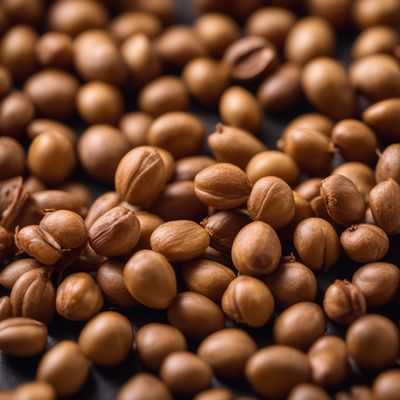
Ingredient
Mat bean (dry seeds)
The Mighty Mat Bean: A Protein-Packed Legume
Mat beans are small, oval-shaped legumes with a beige or brown color. They have a nutty flavor and a slightly grainy texture when cooked. Mat beans are commonly used in Indian cuisine, where they are featured in curries, stews, salads, and sprouted for use in snacks.
Origins and history
Mat beans have been cultivated in India for thousands of years and are an integral part of the country's culinary heritage. They are well-suited to arid climates and are often grown as a drought-resistant crop. Mat beans are not only valued for their nutritional content but also for their ability to fix nitrogen in the soil, making them beneficial for crop rotation and soil fertility.
Nutritional information
Mat beans are a rich source of plant-based protein, dietary fiber, and essential minerals such as iron, potassium, and magnesium. They are also low in fat and cholesterol, making them a healthy choice for vegetarian and vegan diets. Additionally, mat beans contain antioxidants and other bioactive compounds that contribute to their health-promoting properties.
Allergens
Individuals with legume allergies may experience allergic reactions to mat beans. It is advisable to exercise caution and consult with a healthcare professional if you have known legume allergies.
How to select
When selecting mat beans, look for dry seeds that are uniform in size, free from cracks or damage, and have a clean appearance. Avoid beans that appear discolored, moldy, or have an off-putting odor, as these are signs of poor quality or spoilage.
Storage recommendations
To maintain the quality and prevent spoilage, store dried mat beans in an airtight container in a cool, dry pantry or cupboard. Properly stored mat beans can last for up to a year. Cooked mat beans can be stored in the refrigerator for 3-4 days.
How to produce
Mat beans can be grown in home gardens or small-scale farms. They require well-drained soil, full sun, and regular watering. Sow the seeds directly in the ground or in containers, and provide support for the plants to climb if necessary. Harvest the pods when they are fully mature and dry them thoroughly before storing.
Preparation tips
Before cooking mat beans, rinse them thoroughly and soak them in water for at least 4-6 hours or overnight. This helps to soften the beans and reduce cooking time. Mat beans can be boiled, pressure-cooked, or cooked in a slow cooker until tender. They can be used in a variety of dishes, including curries, stews, soups, salads, and sprouted for use in sandwiches or snacks. Experiment with different spices and seasonings to enhance their flavor.
Substitutions
Mung beans or black-eyed peas can be used as substitutes for mat beans in some recipes, as they have a similar size and texture. However, the flavor may differ slightly.
Culinary uses
Mat beans are commonly used in Indian cuisine, where they are featured in dishes such as matki usal (spiced mat bean curry), matki chi usal (sprouted mat bean salad), and matki bhaji (stir-fried mat beans). They can also be added to soups, stews, and grain-based salads for added protein and texture.
Availability
Mat beans are primarily cultivated in India, particularly in the states of Maharashtra, Gujarat, and Rajasthan. They are also grown in other parts of South Asia and some African countries. Mat beans can be found in Indian grocery stores or purchased online as dried seeds.
More ingredients from this category

Horse gram (dry seeds)
The Nutritional Powerhouse: Horse Gram

Black gram (dry seeds)
The Mighty Black Gram: A Nutrient-Packed Legume

Bambara groundnut (dry seeds)
The Hidden Gem of Legumes

Tepary bean (dry seeds)
The Ancient Bean of the Desert

Kersting's groundnut (dry seeds)
The Nutty Delight: Exploring the World of Kersting's Groundnut